How to prepare delicious sauerkraut for the winter
Pickling is the oldest method of preserving vegetables. The main preservative in this process is lactic acid, which is formed during the fermentation process. The compound prevents the spread of pathogenic microflora and gives vegetables a specific smell and taste. Vegetables are fermented in their own juice or in saline solution.
Choosing cabbage for harvesting
Preparing sauerkraut occurs in the fall, when ripe heads of cabbage are tight, hard and heavy. Mid- and late-ripening varieties that contain more sugar and vitamin C than early-ripening varieties are suitable:
- mid-season variety Rinda with dense yellowish-white heads of cabbage weighing up to 3.7 kg;
- high-yielding variety Podarok with flat-rounded, dense heads of cabbage weighing 3.5 kg;
- Belorusskaya cabbage 455 is considered the best for pickling, the heads of cabbage are dense, do not crack, weighing up to 4 kg;
- late-ripening Moscow late 15 produces dense, large heads of cabbage weighing up to 5 kg;
- German Turkiz is resistant to diseases, has dense, small, white heads of cabbage weighing up to 3 kg;
- Miracle for pickling F1 is a mid-season hybrid from Holland, the heads of cabbage are juicy, with a high sugar content, weighing up to 4.5 kg.

The cabbage should be fresh, crisp and sweet in taste, with the outer leaves still intact.. You can use white or red cabbage. If the leaves on a purchased head of cabbage are cut off, the vegetable may have been frozen. There should be no rotten spots on the vegetable, which indicate infection with a fungus.Damaged leaves indicate that the vegetable is being affected by pests.
Preparation for cooking begins with washing and peeling the vegetables, and cutting out the cabbage stalk. Rock salt is used; iodized salt makes the heads of cabbage soft.
Important! If a bay leaf is used in a recipe, soak it in cold water the first time for 30 minutes, the second time for 10 minutes, and then rinse with clean water.
The container is washed, dried, glass jars are sterilized for 10 minutes in an oven preheated to 100°C or over steam. To do this, place a cover with a hole for a jar on a pan of hot water. The jar is placed on the plate before the water boils, so that it warms up gradually, and is sterilized for 5 minutes from the moment the water boils. Take the sterilized jar with a clean kitchen towel and place it, neck down, on another towel to cool. Both towels are ironed in advance on both sides with a hot iron.
Preparations from other vegetables:
Salted brown tomatoes: best recipes
How to properly prepare delicious sauerkraut
A classic quick recipe requires a minimum of ingredients.
Ingredients for a three-liter jar:
- cabbage – 3.2 kg;
- carrots – 1 pc.;
- salt – 3 tbsp. l.;
- sugar – 2 tbsp. l.;
- bay leaf – 2-3 pcs.
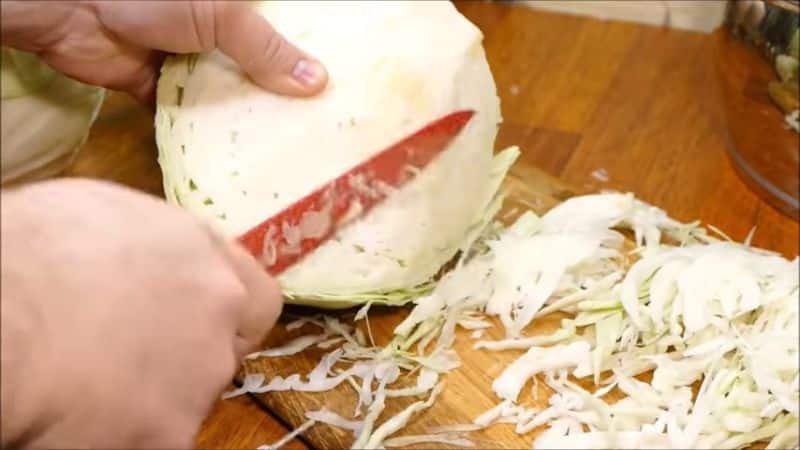
Step-by-step instruction:
- The head of cabbage is chopped, the carrots are grated on a coarse grater, and mixed with cabbage in a large container.
- Gently mash the vegetables with your hands so that the cabbage gives juice but remains crispy, add salt and sugar.
- The vegetables are placed in a clean, dry jar in small layers, layered with bay leaves, and each layer is compacted tightly by hand.The neck of the jar should be filled with juice, which rises to the top as the jar fills.
- During fermentation, cabbage will produce a lot of juice, so place the jar in a container with high edges, cover with gauze and leave to ferment at room temperature for 3 days. In the morning and evening, the workpiece is pierced in several places to the bottom with a wooden stick to release carbon dioxide.
- On the fourth day, close the jar with a lid and put it in the refrigerator for storage.
Selection of containers
Vegetables in small quantities can be fermented in a glass jar or in enamel containers without chips, and if you need a lot of cabbage, the best container is a linden or oak barrel. For a long time in Rus', vegetables were fermented in barrels and stored in the cellar; they did not lose their taste and beneficial properties all winter.
Before fermentation, the barrel is filled with water for several days, the wood swells and the small cracks between the boards close. After this, the barrel is washed with a solution of 35 g of soda per 12 liters of water, then doused with boiling water three times.

You can ferment cabbage in a plastic bucket. Before this, the bucket is washed with soda, soaked for a day in clean water, then rinsed and dried. The cabbage is fermented until fully cooked, then transferred to glass jars.
Attention! The bucket should only be made of white or colorless plastic for food products.
You cannot ferment vegetables in metal containers.: during the fermentation process, the acid reacts with the metal, vegetables lose their taste and, instead of being beneficial, can cause harm to the body.
Recipe Variations
The most delicious and popular recipes that allow you to try a new taste of a familiar dish every year.
Like grandma's
Traditional way of sourdough.
Ingredients:
- white cabbage – 5 kg;
- carrots – 1 kg;
- salt – 100 g.
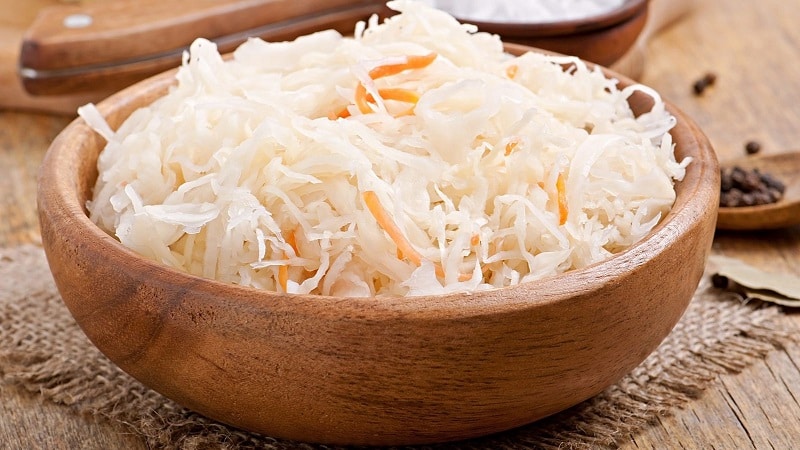
How to cook:
- The prepared fork is finely chopped, the carrots are grated on a coarse grater, the vegetables are mixed with salt, gently kneading with your hands.
- The vegetables are placed in a jar, carefully compacted to the top; they should be completely covered with juice on top.
- The jar is placed in a container with high edges, covered with gauze and left to ferment at room temperature for two days.
- In the morning and evening, the cabbage is pierced in several places to the bottom with a wooden stick to release carbon dioxide.
- On the second day, close the jar with a lid and put it in the refrigerator for storage.
Without salt and sugar
The taste of cooked cabbage is sour; it can be eaten with onions and butter or added to salads.
Ingredients for a three-liter jar:
- white cabbage – 1 head;
- boiled or filtered water – 1 glass.

How to cook:
- The prepared head of cabbage is chopped into strips, placed tightly in a three-liter jar, 10 cm from the top of the jar is left empty, water is poured here and covered with a lid or gauze.
- The jar is placed in a container with high edges and left to ferment at room temperature for three days.
- In the morning and evening, the cabbage is pierced in several places to the bottom with a wooden stick to release carbon dioxide.
- After this, the jar is closed with a lid and placed in the refrigerator for storage.
In Georgian
Pepper and garlic give cabbage a spicy kick.
Ingredients:
- cabbage – 3 kg;
- beets – 2 pcs.;
- hot pepper – 1 pc.;
- garlic – 1 head;
- salt, sugar - 75 g each;
- water – 1.5 l.
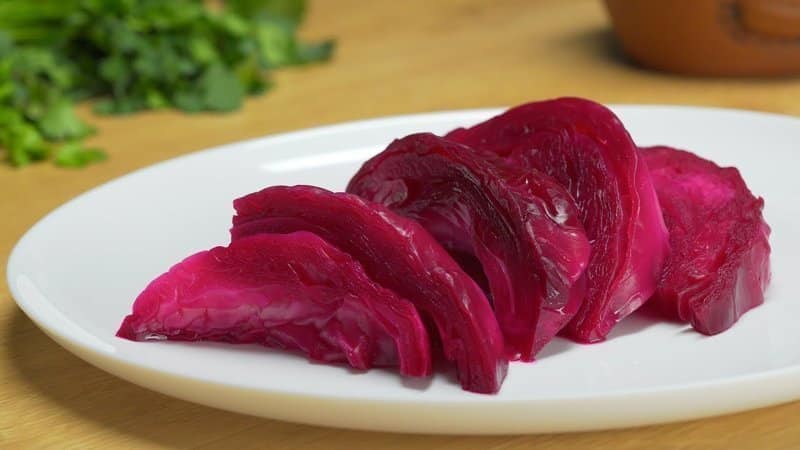
How to cook:
- Cabbage and peppers are cut into large pieces, beets and garlic into thin slices.
- The cabbage is placed tightly in a jar, topped with pepper, beets and garlic, and poured with a brine of salt, sugar and water that has been boiled and cooled until warm.
- The jar is placed in a container with high edges, where the brine will flow out of the jar and left to ferment at room temperature for 5-7 days.
- Next, close the jar with a lid and put it in the refrigerator for storage.
Read also:
With cranberries
Cranberries add sourness to the product and extend its shelf life. Cranberries can be replaced with lingonberries.
Ingredients:
- cabbage – 5 kg;
- carrots – 1.5 kg;
- cranberries – 300 g;
- salt, sugar - 6 tbsp. l.
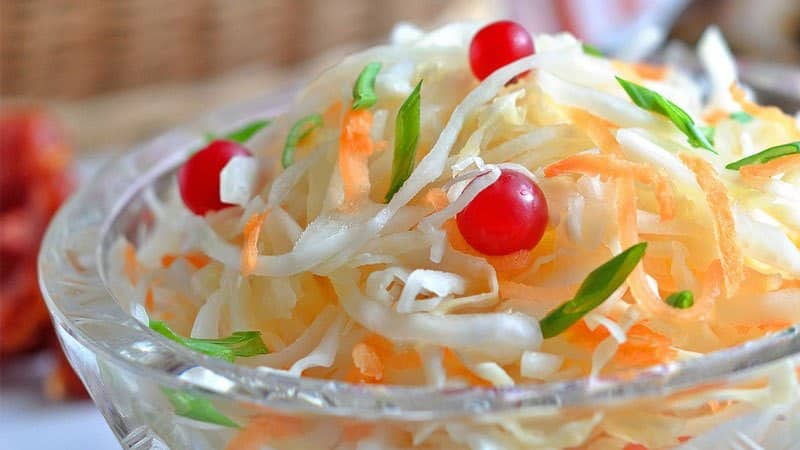
How to cook:
- The prepared head of cabbage is finely chopped, the carrots are grated on a coarse grater, the vegetables are mixed with salt and sugar, gently kneading with your hands until juice appears.
- The cabbage is placed in jars, topped with cranberries, and the vegetables should be completely covered with juice on top.
- The cabbage is lightly crushed, not compacted, so as not to damage the cranberries.
- The jars are placed in a container with high edges, covered with gauze and left to ferment at room temperature for 7 days.
- In the morning and evening, vegetables are pierced in several places to the bottom with a wooden stick.
- On the eighth day, the jars are closed with a lid and placed in the refrigerator for storage.
With apples
Apples give a sweet and sour taste and a pleasant aroma.
Ingredients:
- cabbage – 1 kg;
- carrots – 1 pc.;
- apples – 1 pc.;
- salt – 20 g;
- sugar – 5 g.
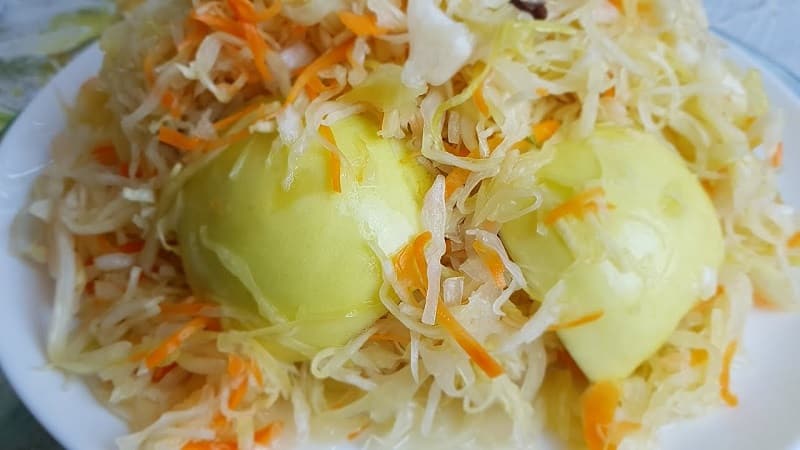
How to cook:
- The prepared cabbage is finely chopped, the carrots are grated, the apple is peeled from seeds and peel and cut into slices.
- Mix vegetables and apples with salt and sugar until juice appears, transfer to a jar, compacting thoroughly. The top of the vegetables should be completely covered with juice.
- The jar is placed in a container with high edges, covered with gauze and left to ferment at room temperature.
- In the morning and evening, the cabbage is pierced in several places to the bottom with a wooden stick to release carbon dioxide.
- After 3-4 days, close the jar with a lid and put it in the refrigerator for storage.
With beets
Beetroot adds vitamins to the preparation and colors the cabbage in a bright color.
Ingredients:
- cabbage – 2.5 kg;
- beets – 400 g;
- black pepper – 3-5 peas;
- salt, sugar - 30 g each;
- water – 1 l.
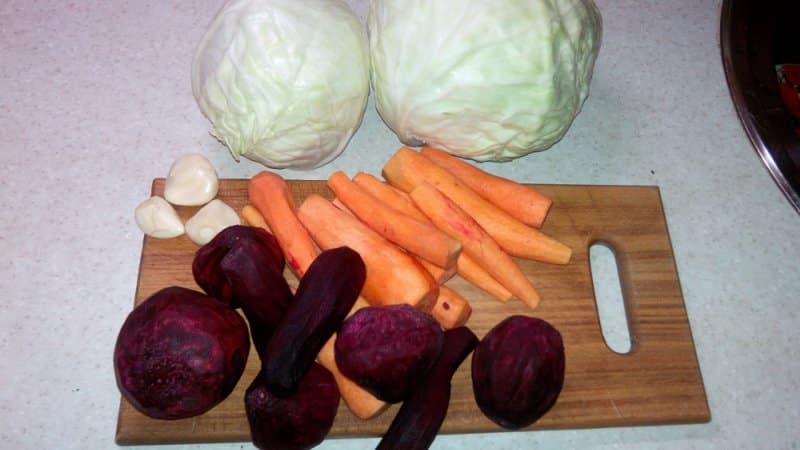
How to cook:
- Cabbage is cut into large pieces, beets into thin slices. Mix the vegetables into a jar and add pepper.
- Salt and sugar are dissolved in cold boiled water, the brine is poured over the vegetables, the jar is placed in a container with high edges, where the brine will flow out of the jar, and left to ferment at room temperature for 5-7 days.
- Lightly stir the cabbage with a knife or wooden stick to release the gas.
- After this, the jar is closed with a lid and placed in the refrigerator for storage.
Terms and conditions of storage
The beneficial properties and taste of sauerkraut are preserved only when proper storage:
- Storage temperature should be +2…+5°С. At higher temperatures, the workpiece may not be preserved. Cabbage is also stored in the freezer in portioned containers.
- During storage, fungus may appear in the workpiece - a white coating on top. For prevention, the workpiece is sprinkled with dry mustard, granulated sugar or grated horseradish root on top.
- To prevent the top layer of cabbage from darkening, the brine should be above it. If the brine becomes insufficient, you can add it by stirring 1 tbsp. l. salt with a slide in 1 liter of boiled and cooled water.
- The shelf life depends on the container: in the refrigerator in a plastic container, cabbage is stored for no more than 6 days, in a glass jar - up to 2 months, in the freezer - 7-8 months.
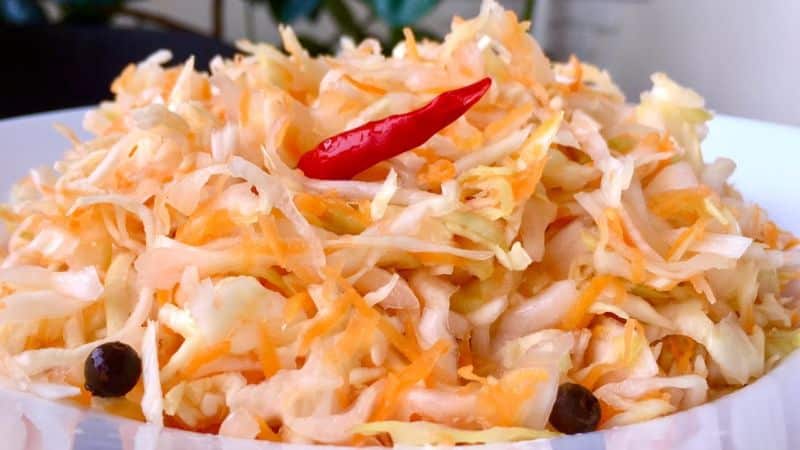
Advice from experienced housewives
Eat a few secrets that will help in preparing sauerkraut:
- the heads of cabbage should be dense;
- if vegetables are fermented in a wide-necked container, a pressure in the form of a jar of water is placed on it;
- if there is a lot of cabbage, you can use a special shredder;
- to make the cabbage more acidic, it is fermented for 8-9 days;
- if you ferment vegetables in a large container and put a whole head of cabbage inside, in winter you can make cabbage rolls from sauerkraut leaves;
- bubbles and foam that appear on the brine should be removed.
Conclusion
It’s not difficult to prepare delicious sauerkraut for the winter. The main ingredients are cabbage, carrots and salt; you can add other vegetables, fruits, berries, and spices to taste. Before placing the vegetables in the jar, gently knead them with your hands until the cabbage releases juice. Store cabbage at a temperature no higher than +5°C.